- Joined
- Oct 9, 2007
- Messages
- 47,653 (7.44/day)
- Location
- Dublin, Ireland
| System Name | RBMK-1000 |
|---|---|
| Processor | AMD Ryzen 7 5700G |
| Motherboard | Gigabyte B550 AORUS Elite V2 |
| Cooling | DeepCool Gammax L240 V2 |
| Memory | 2x 16GB DDR4-3200 |
| Video Card(s) | Galax RTX 4070 Ti EX |
| Storage | Samsung 990 1TB |
| Display(s) | BenQ 1440p 60 Hz 27-inch |
| Case | Corsair Carbide 100R |
| Audio Device(s) | ASUS SupremeFX S1220A |
| Power Supply | Cooler Master MWE Gold 650W |
| Mouse | ASUS ROG Strix Impact |
| Keyboard | Gamdias Hermes E2 |
| Software | Windows 11 Pro |
AMD at its 2019 Computex private showcase for the media following its CEO's keynote address, unveiled several premium motherboards based on the new AMD X570 chipset. The X570 is an in-house design effort by AMD, and unlike the X470, isn't sourced from ASMedia. The chipset supports PCI-Express gen 4.0 end-to-end, which means not only is the chipset-bus gen 4.0, but also the downstream PCIe lanes it puts out. The chipset connects to the AM4 socket over a PCI-Express 4.0 x4 link (64 Gbps).
It has a downstream PCIe lane budget of 16 lanes, which the motherboard designers can spread out as up up to two M.2 NVMe slots, an x4 (physical x16) slot, a bunch of x1 slots, and newer generation connectivity such as 802.11ax WLAN, 2.5/5.0/10 GbE wired networking, and a larger number of USB 3.2 ports, including newer 20 Gbps portsn over external controllers. This chipset runs hotter than the X470, with a TDP rumored to be around 15W, probably because of the PCIe gen 4.0 implementation. Many of the motherboards we spotted had active fan-heatsinks over the chipset.
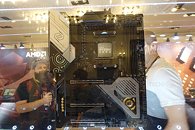

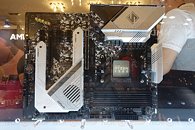

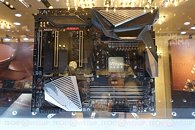
Among the motherboards we spied through glass shelves are the ASRock X570 Taichi which its characteristic steampunk design that tries hard to conceal the chipset fan behind a grille. ASRock does something similar with the X570 Steel Legend (but doubles down on the digital camo print). The GIGABYTE Aorus X570 Master is a monstrosity with a design focus on an outrageously strong CPU VRM that pulls power from two 8-pin EPS connectors, and a heavy dose on the areas GIGABYTE has earned a reputation for, such as onboard audio, durable electrical components, etc. There's also a bare GIGABYTE board that shows off the X570 chipset, with its rather large (roughly 130 mm²) die.




The X570 Aorus Pro has a more sober design, with an unwavering focus on VRM heatsink design, two M.2 slots, and a reasonably good connectivity load-out. GIGABYTE thinks the AMD X570 is a safe enough bet to pull out its flagship Aorus Xtreme brand, and the X570 Aorus Xtreme is possibly the most fleshed out board we saw, with a monstrous CPU VRM, and a fanless chipset heatsink that's spread out better, and shares some of its heat with the VRM heatsink over a heat-pipe.
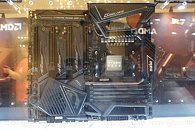


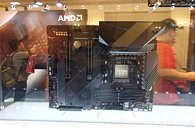
MSI, like GIGABYTE, is betting big on X570, and has designed its flagship MEG X570 GODLIKE motherboard based on this chipset, with its gargantuan heatsink. There's also the MEG X570 Creation, and the MEG X570 Ace that MSI had teased earlier this month, with a slightly toned down feature set, which still qualifies as high-end/enthusiast. This platform makes choosing Intel look like a compromise. ASUS deployed its ROG, TUF, and Prime brands for the X570, and within ROG, there's will be ROG Strix and ROG Crosshair brands. ASUS unveiled a board that could very well be the Crosshair VIII Formula. There's also the sober-looking Prime X570-Pro. Lastly, there's the ASUS TUF X570 Gaming.

View at TechPowerUp Main Site
It has a downstream PCIe lane budget of 16 lanes, which the motherboard designers can spread out as up up to two M.2 NVMe slots, an x4 (physical x16) slot, a bunch of x1 slots, and newer generation connectivity such as 802.11ax WLAN, 2.5/5.0/10 GbE wired networking, and a larger number of USB 3.2 ports, including newer 20 Gbps portsn over external controllers. This chipset runs hotter than the X470, with a TDP rumored to be around 15W, probably because of the PCIe gen 4.0 implementation. Many of the motherboards we spotted had active fan-heatsinks over the chipset.





Among the motherboards we spied through glass shelves are the ASRock X570 Taichi which its characteristic steampunk design that tries hard to conceal the chipset fan behind a grille. ASRock does something similar with the X570 Steel Legend (but doubles down on the digital camo print). The GIGABYTE Aorus X570 Master is a monstrosity with a design focus on an outrageously strong CPU VRM that pulls power from two 8-pin EPS connectors, and a heavy dose on the areas GIGABYTE has earned a reputation for, such as onboard audio, durable electrical components, etc. There's also a bare GIGABYTE board that shows off the X570 chipset, with its rather large (roughly 130 mm²) die.




The X570 Aorus Pro has a more sober design, with an unwavering focus on VRM heatsink design, two M.2 slots, and a reasonably good connectivity load-out. GIGABYTE thinks the AMD X570 is a safe enough bet to pull out its flagship Aorus Xtreme brand, and the X570 Aorus Xtreme is possibly the most fleshed out board we saw, with a monstrous CPU VRM, and a fanless chipset heatsink that's spread out better, and shares some of its heat with the VRM heatsink over a heat-pipe.




MSI, like GIGABYTE, is betting big on X570, and has designed its flagship MEG X570 GODLIKE motherboard based on this chipset, with its gargantuan heatsink. There's also the MEG X570 Creation, and the MEG X570 Ace that MSI had teased earlier this month, with a slightly toned down feature set, which still qualifies as high-end/enthusiast. This platform makes choosing Intel look like a compromise. ASUS deployed its ROG, TUF, and Prime brands for the X570, and within ROG, there's will be ROG Strix and ROG Crosshair brands. ASUS unveiled a board that could very well be the Crosshair VIII Formula. There's also the sober-looking Prime X570-Pro. Lastly, there's the ASUS TUF X570 Gaming.

View at TechPowerUp Main Site







 Only "budget bros" can spot a real steal of a deal!
Only "budget bros" can spot a real steal of a deal! 